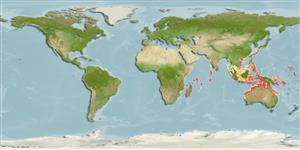Teleostei (teleosts) >
Eupercaria/misc (Various families in series Eupercaria) >
Haemulidae (Grunts) > Plectorhinchinae
Etymology: Diagramma: Greek, diagramma = mark out by lines (Ref. 45335).
More on author: Macleay.
Environment: milieu / climate zone / depth range / distribution range
Ecology
Marine; brackish; benthopelagic. Subtropical
Indo-West Pacific: range from northern Australia and southern New Guinea.
Size / Weight / Age
Maturity: Lm ? range ? - ? cm
Max length : 90.0 cm TL male/unsexed; (Ref. 41841); max. published weight: 6.3 kg (Ref. 41841)
Found in shallow estuaries and lagoons (juveniles) and along slopes, deep lagoons for adults, usually in large schools (Ref. 9002). At about 25 cm TL the body form changes from a long, round, caudal fin to the adult form, being a truncate fin (T. Turner, pers. comm., 2002).
Life cycle and mating behavior
Maturities | Reproduction | Spawnings | Egg(s) | Fecundities | Larvae
Distinct pairing during breeding (Ref. 205).
Parenti, P., 2019. An annotated checklist of the fishes of the family Haemulidae (Teleostei: Perciformes). Iran. J. Ichthyol. 6(3):150-196. (Ref. 119443)
IUCN Red List Status (Ref. 130435)
Threat to humans
Harmless
Human uses
Tools
Special reports
Download XML
Internet sources
Estimates based on models
Preferred temperature (Ref.
123201): 25 - 28.9, mean 27.7 °C (based on 608 cells).
Phylogenetic diversity index (Ref.
82804): PD
50 = 0.5312 [Uniqueness, from 0.5 = low to 2.0 = high].
Bayesian length-weight: a=0.01950 (0.00846 - 0.04494), b=2.95 (2.75 - 3.15), in cm total length, based on LWR estimates for this (Sub)family-body shape (Ref.
93245).
Trophic level (Ref.
69278): 3.8 ±0.5 se; based on size and trophs of closest relatives
Resilience (Ref.
120179): Low, minimum population doubling time 4.5 - 14 years (Preliminary K or Fecundity.).
Fishing Vulnerability (Ref.
59153): High vulnerability (56 of 100).
Nutrients (Ref.
124155): Calcium = 25.4 [10.4, 88.5] mg/100g; Iron = 0.598 [0.206, 1.678] mg/100g; Protein = 18.8 [16.3, 21.2] %; Omega3 = 0.201 [0.080, 0.465] g/100g; Selenium = 30.3 [9.0, 106.3] μg/100g; VitaminA = 9.16 [2.70, 29.59] μg/100g; Zinc = 0.412 [0.205, 1.074] mg/100g (wet weight);
